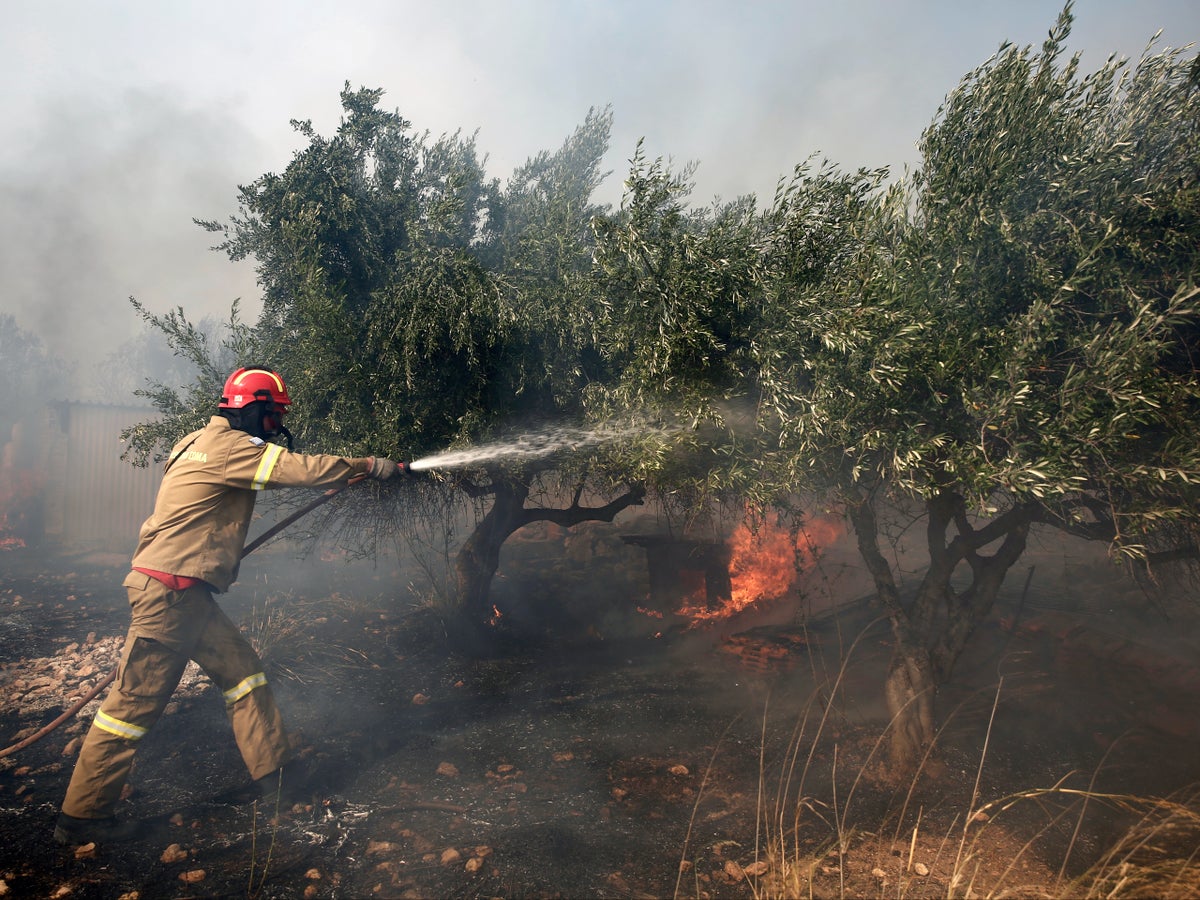
Raging wildfires forced the evacuation of holiday villages in Greece on Monday as Europe was braced for record temperatures and meteorologists warned the deadly heatwave was likely to stretch into August.
With fires still burning on La Palma in the Canary Islands, where more than 4,000 people were evacuated on Sunday, two separate blazes which ignited near Athens on Monday saw hundreds of children forced to flee a summer camp and villagers abandon their homes.
Fanned by high winds, the inferno in Kouvaras – a town just 17 miles from the Greek capital – tore through seven miles in just two hours, with television footage showing several houses and cars gutted by the blaze and thick white smoke billowing from burning vegetation.
Flames burn an olive grove in Lagonisi, near Athens— ( EPA/YANNIS KOLESIDIS)
A man was arrested on suspicion of arson, as hundreds of firefighters, soldiers and volunteers grappled with the fire. Fifty-five miles away, near the seaside resort of Loutraki, some 1,200 children from a summer camp and residents of a rehab centre were evacuated.
The fire alert level was also raised in Athens and much of southern Greece, mirroring the picture across Spain, with countries further from the Mediterranean – including North Macedonia and Kosovo – also issuing extreme heat alerts.
“Never in my life have I experienced heat like this before in Pristina,” Artan Kelani, a 22-year-old student, said in Kosovo’s capital, where it reached 34.4C on Monday.
The World Meteorological Organisation warned the heat would only intensify in midweek, with the north African anti-cyclone Charon – named after the Greek mythological ferryman of the dead – potentially setting new national records as it lifts temperatures well above 45C in parts of Italy, Spain and Greece.
In Italy, the health ministry urged regions to beef up house-call services so older people would not have to brave the heat to receive medical care, and to set up dedicated heat stations at hospitals to treat emergency cases.
A house was left burning near the town of Loutraki— (AP)
A woman gives water to her horse as her husband on a tractor tries to extinguish the fire with a hose near Loutraki— (AP)
In Rome, where the mercury was set to hit 42C on Tuesday, volunteers and water company officials planned to be out in force to direct sweltering tourists and locals to fountains and distribute bottled water at dozens of locations across the city, including the Colosseum.
With temperatures already at 39C on Monday, parts of the Italian capital were hit by power outages, as electric grids faced under heavy demand from air conditioners, while in more rural areas, Italy’s farming lobby group Coldiretti said stressed cows were producing 10 per cent less milk due to the heat.
A woman cools off at Fontana della Barcaccia at the Spanish Steps in Rome— (REUTERS/Guglielmo Mangiapane)
“The bubble of hot air that has inflated over southern Europe has turned Italy and surrounding countries into a giant pizza oven,” said Professor Hannah Cloke, of the University of Reading.
“The hot air which pushed in from Africa is now staying put, with settled high-pressure conditions meaning that heat in warm sea, land and air continues to build.”
In Spain, the wildfire which started on Saturday on La Palma continued to burn out of control, having ravaged some 460 square kilometres – an area larger than Glasgow.
But authorities said weaker winds and cooler temperatures were helping firefighters combat it, and the 4,000 residents previously evacuated were allowed to start returning to their homes late on Sunday.
It was not only Europe facing record-breaking heat, however, with historic temperatures set to be surpassed in the United States and in China, which both resumed negotiations on Monday over action to curb climate change by cutting methane emissions and coal power.
Prof Cloke warned that the simultaneous events were evidence that the dire computer simulations of the past had now arrived.
“It is not surprising that different parts of the northern hemisphere have heatwaves during our summer months, but the combined picture is starting to look like climate change impacts all happening at the same time, as scientists have forecast for decades,” she said.
We are now living through these impacts, rather than predicting them in a computer simulation of the future climate.
“Sea level rise, melting ice, extreme heatwaves, intense rainfall, wildfires, drought and floods are cropping up in many parts of the world at the same time. In previous heatwaves, such as Britain’s hot summer of 1976, other parts of the globe had a relatively cool year. Today’s extremes of weather are increasingly throwing everything everywhere all at once.”
Additional reporting by agencies







